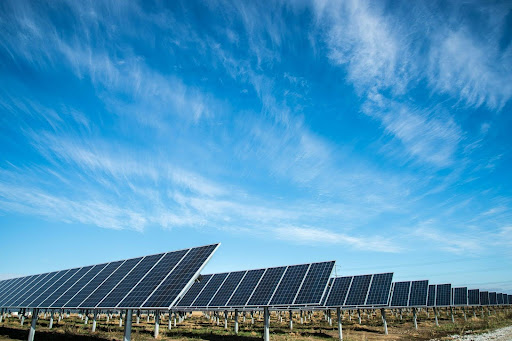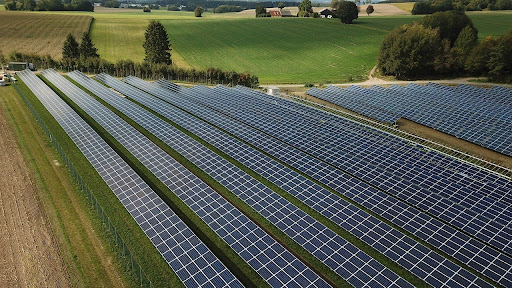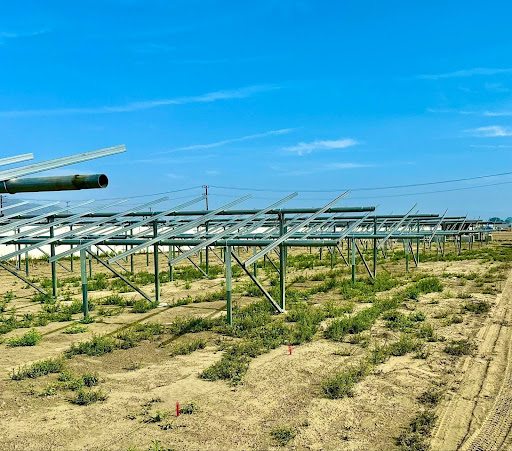Do Solar Farms Damage The Soil? Ground Mount Panels Impact Explained
Key Takeaways
- Solar farms offer environmental benefits, such as reducing carbon emissions and promoting sustainable land use.
- Soil compaction may occur due to the installation of solar panels, which can affect its structure and permeability.
- Negative impacts can be mitigated and biodiversity can be enhanced through proper vegetation management under solar panels.
- Energy production and soil conservation can be balanced through innovative practices and technologies.
- Nuance Energy’s Osprey PowerRACK® system has a simple installation process and eliminates the need for concrete or pile-driving, making it a more environmentally friendly solution.
How Solar Panel Installation Impacts Soil Health
Soil is a key part of our ecosystem, supporting plant life, storing carbon, and filtering water. It’s necessary to evaluate how soil health is affected by solar farms to make informed decisions about renewable energy development.
Soil Compaction
Building solar farms often requires the use of heavy machinery to install panels and other infrastructure. This can result in soil compaction, a process where soil particles are pushed together, reducing the spaces in between them and limiting the movement of air and water. Soil compaction stunts root growth, decreases water infiltration, and increases runoff, which can cause erosion.

Conventional solar farms can alter soil temperatures and impact microclimates.
Alterations in Soil Temperature and Microclimate
The microclimate under traditional ground mount solar panels can also be affected. The shading of the soil by the panels lowers soil temperatures, which may have an impact on the growth of some plant species. However, this shading effect can be advantageous in warmer climates where it aids in the preservation of soil moisture.
Effect on Soil Moisture Levels
Solar panels can change the distribution of rain and irrigation water, impacting soil moisture levels. Although panels can help preserve moisture by decreasing evaporation, they might also divert water from some areas, possibly resulting in uneven moisture distribution.
Long-Term Impact on Soil Composition
As the years pass, solar panels can cause alterations to the soil composition. For example, the buildup of organic matter from plants growing under the panels can enhance soil fertility. But, if not handled correctly, the absence of plant cover can lead to soil degradation.

A thoughtfully planned solar farm minimizes disruptions in local ecosystems and helps conserve biodiversity.
| Nuance Energy is your superior solution for Ground Mount solar. Our patented foundation technology Osprey PowerRACK® allows for rapid installation using only handheld tools, significantly reducing both time and costs compared to traditional racking systems.
This cutting-edge technology works for residential and commercial installations, and Nuance Energy empowers solar installers to take back control of their installation schedules, control project COGS, gain market share, increase the speed of installation, and reduce the cost of labor. In contrast, a traditional ground mount is much more unpredictable, slower, and costly. Find out how Nuance Energy can accelerate your solar projects with the Osprey PowerRACK® line, and boost your profitability. Contact us today to discuss our innovative ground-mount solutions. |
How Solar Farms Interact with the Environment
Local Ecosystems
Solar farms have the potential to disrupt local ecosystems, mainly through land alteration and habitat fragmentation. Clearing a large area for solar panels can displace native plant species and wildlife, disrupting existing ecological networks. The extent of the disruption, however, depends on the original condition of the land and the design of the solar farm.
For example, in areas where solar farms are built on land that is already degraded, the overall impact on the environment will be small. On the other hand, building solar farms in areas with a lot of biodiversity can result in a significant loss of habitat. That’s why it’s so important to do a complete environmental assessment before starting construction.
One study showed that UK solar farms could coexist with local wildlife if they were planned carefully. This includes adding features such as hedgerows and wildflower meadows, which support biodiversity.
Therefore, the answer is to include ecological considerations in the planning and design of solar farms. This will help to reduce any negative effects and could even improve local biodiversity.
The Importance of Plant Life Beneath Solar Panels
Plant life is vital in reducing the effect of solar farms on the health of the soil. By keeping plants under and around solar panels, we can stop soil erosion, improve soil fertility, and help local wildlife. This method, called agrivoltaics, is the combined use of land for farming and solar energy production.
Moreover, the presence of vegetation generates a cooling effect, which enhances the efficiency of solar panels. Native plant species are usually the go-to because of their adaptability and low maintenance requirements. By nurturing a diverse plant community, solar farms can have a positive impact on the environment.

The presence of vegetation around solar farms can create a cooling effect and enhance solar panel efficiency.
How Do Solar Farms Impact Birds and Wildlife?
While the solar panels themselves don’t pose a direct threat to wildlife, the infrastructure that comes with them and the changes they bring to habitats can create problems.
For instance, terrestrial animals may be restricted in their movement due to fencing around solar farms, while birds may be confused by reflective surfaces. To solve these problems, developers can use wildlife-friendly designs, like making corridors for animal movement and using non-reflective materials.
Ways to Reduce the Impact on Soil
Progress in Solar Farm Technology
Progress in technology has led to the development of more eco-friendly solar farm designs. New technologies, such as raised solar panels and adjustable mounting systems, allow for improved land use and less soil disruption. These technologies allow solar panels to coexist with existing land uses, such as farming or grazing.
In addition, improvements in panel materials and installation methods can minimize the environmental impact of solar farms. Using lighter materials and modular designs reduces the need for extensive ground preparation, which helps to maintain soil structure and health.
For example, Nuance Energy’s Osprey PowerRACK® is adaptable to almost any type of soil or site while also minimizing environmental impact with its use of earth anchoring technology. Additionally, its use of vertically adjustable legs further helps preserve the natural landscape and pre-existing soil ecosystems.
Using Techniques to Preserve the Soil
Preserving the soil is important for keeping it healthy in solar farm environments. Techniques like minimal tillage, mulching, and cover cropping improve the structure of the soil, its fertility, and how well it retains moisture. Solar farms can support the sustainable management of land by using these techniques.
When soil conservation is made a priority, solar farms have the potential to play a significant role in promoting long-term environmental sustainability.
Looking at the Possibilities of Double Land Usage
Double land usage possibilities like agrivoltaics are a hopeful answer to the need for energy production and soil conservation. By combining solar panels with agricultural practices, we can make the best use of the land and create multiple benefits.
For example, merging solar power production with crop cultivation or grazing can improve soil health and provide economic benefits. Grazing animals, like sheep, can assist in managing vegetation under solar panels, lowering maintenance costs and promoting biodiversity.
Why Choose Nuance Energy’s Osprey PowerRACK® System?

For solar farms to be truly sustainable, both from an environmental and economic standpoint, a thorough review of their impacts and benefits is necessary. This includes looking at potential effects on soil health, biodiversity, and local communities, as well as the economic return and energy production capabilities.
Incorporating concepts like agrivoltaics into the planning process and using other innovative systems like Nuance Energy’s Osprey PowerRACK® helps minimize environmental impact and disruptions in the soil’s microclimate and surrounding ecosystems. Here’s why you should consider our innovative system:
- Reduced Installation Time: Our patented earth anchor system technology, which can be installed using only handheld tools, eliminates the need for multiple mobilizations and heavy equipment.
- Predictable Costs: The absence of heavy equipment and complex labor results in a highly predictable cost structure.
- Minimal Environmental Impact: Osprey PowerRACK® is a more eco-friendly choice, as it avoids concrete use, reducing CO2 emissions.
- Durability and Stability: The earth anchor system secures the racking system to the ground, providing resilience against wind and seismic events.
- Adaptable to Challenging Terrains: It works efficiently on various terrains without the need for additional foundation work.
- Suited for All Project Sizes: Osprey PowerRACK® works for residential and smaller-scale commercial projects, scaling efficiently across different market segments.
- Jurisdictional Compliance: Real-time testing and compliant engineering reports expedite approvals across multiple jurisdictions.
Have an upcoming solar project? Get in touch with our team for answers to all your questions and a free quote on our products.
Frequently Asked Questions
How do solar farms affect soil biodiversity?
Solar farms can impact soil biodiversity by altering habitat conditions and affecting the composition of plant and animal communities. However, with proper management, solar farms can also enhance biodiversity by providing habitats for pollinators and other wildlife.
Is it possible to combine solar farms with farming?
Absolutely, through a method called agrivoltaics, solar farms and farming can be integrated. This allows for the land to be used for both solar energy and farming, optimizing its use. There are also other benefits such as healthier soil and increased crop yield.
For instance, some solar farms allow livestock like sheep to graze under the solar panels. This helps manage the vegetation, reduces maintenance costs, and promotes biodiversity.
How can soil be safeguarded during solar panel installation?
This can be accomplished by reducing soil disturbance and compaction. It’s possible to achieve this by using less heavy machinery, using low-impact installation methods, and keeping vegetation cover.
Does solar farming have a lasting impact on soil quality?
The lasting impact of solar farming on soil quality will vary based on factors such as how the site is managed and the environmental conditions. If managed correctly, solar farms can maintain or even improve soil quality. They can prevent erosion, increase organic matter, and support biodiversity.
Nonetheless, if not properly planned and managed, solar farms could cause soil compaction, erosion, and loss of habitat, which can have a negative effect on soil health and ecosystem services.
Save Time & Money on Your Next Solar Project
Request a QuoteRECENT POSTS
- DPW Solar vs Nuance Energy Mounted Solar Options: Cost & Benefits
- Geotechnical Report Cost & Requirements For Solar Projects
- Are Solar Panels Worth It In Nevada? Costs & Options
- OSPREY PowerRack Ground Mount System Compatibility: Single- and Dual-Axis Trackers
- Rammed Earth Foundation For Solar Arrays: Cost, Pros & Cons
- Agrivoltaics Explained: Solar & Agriculture Combined
- Large Scale Solar Systems Options: Pros & Cons
- Best Solar Options For Farms & Agriculture: Cost, Pros & Cons
- Unirac vs MT Solar Mounted Options: Cost & Benefits
- IronRidge vs Grengy Mounted Solar Options: Cost & Benefits

